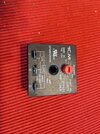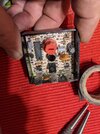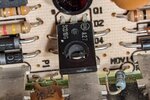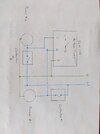I shorted the out put lead to grounds and burnt up my bypass controller yesterday. I suspect the transistor that makes the actual bypass, in place of a relay, has been fried.
This unit seems to be a rather simple circuit with a voltage input of between 18 vac and 240vac as an input to leads 2 and 3. The output lead 1 connects to input lug 2 internally for a short timed duration. To make the bypass in the circuit, output lug 1 is connected through the load to the input lug 3. This connection is timed and the internal lug 2 to lug 1 connection drops out after a set timed duration.
In my circuit it will energize pump 2 for a short time through the by-pass relay every time pump #1 gets powered to start, no matter what controller #2 state is .
I will attach a simple circuit drawing.
The by-pass relay is an electronic device, no mechanical relays at all. It is an ICM175 unit. It has a limit of 1 amp with 10am surge. This unit is usually used in the HVAC world to by-pass a low pressure sensor in very cold conditions for a very short time, then cuts out. I'm using it to energize a small pump for a short time, (0.75 amp) then cut out.
After the 20 amp surge through the unit, I have taken the unit apart and can see the transistor. It looks OK, no burn marks that can be seen, but doesn't function any longer as it did before it took the full 20amps hit, delivered by the power source. I would like to replace the transistor, but I have searched to the limit of my abilities and can't seem to find any data on it.
The transistor reads that it is manufactured by "ON" and has then number "scd10G". there is also another number "A27" printed on it.
I'll attach some photos.
Any help to find a replacement transistor or deeper thoughts of getting this fixed, would be appreciated.
thanks Rex
This unit seems to be a rather simple circuit with a voltage input of between 18 vac and 240vac as an input to leads 2 and 3. The output lead 1 connects to input lug 2 internally for a short timed duration. To make the bypass in the circuit, output lug 1 is connected through the load to the input lug 3. This connection is timed and the internal lug 2 to lug 1 connection drops out after a set timed duration.
In my circuit it will energize pump 2 for a short time through the by-pass relay every time pump #1 gets powered to start, no matter what controller #2 state is .
I will attach a simple circuit drawing.
The by-pass relay is an electronic device, no mechanical relays at all. It is an ICM175 unit. It has a limit of 1 amp with 10am surge. This unit is usually used in the HVAC world to by-pass a low pressure sensor in very cold conditions for a very short time, then cuts out. I'm using it to energize a small pump for a short time, (0.75 amp) then cut out.
After the 20 amp surge through the unit, I have taken the unit apart and can see the transistor. It looks OK, no burn marks that can be seen, but doesn't function any longer as it did before it took the full 20amps hit, delivered by the power source. I would like to replace the transistor, but I have searched to the limit of my abilities and can't seem to find any data on it.
The transistor reads that it is manufactured by "ON" and has then number "scd10G". there is also another number "A27" printed on it.
I'll attach some photos.
Any help to find a replacement transistor or deeper thoughts of getting this fixed, would be appreciated.
thanks Rex
Attachments
Last edited:





